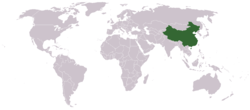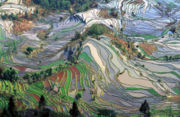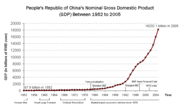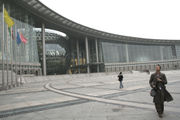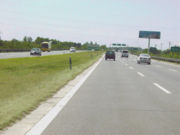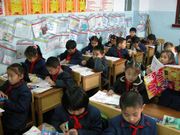People's Republic of China
2007 Schools Wikipedia Selection. Related subjects: Asian Countries; Countries
| 中华人民共和国 中華人民共和國 Zhōnghuá Rénmín Gònghéguó People's Republic of China |
|||||
|
|||||
| Anthem: Yìyǒngjūn Jìnxíngqǔ (义勇军进行曲) March of the Volunteers |
|||||
| Capital | Beijing |
||||
|---|---|---|---|---|---|
| Largest city | Shanghai | ||||
| Official languages | Standard Mandarin1 ( Putonghua) Chinese | ||||
| Government | Socialist republic2 | ||||
| - President | Hu Jintao | ||||
| - Premier | Wen Jiabao | ||||
| Establishment | |||||
| - Chinese civilization | around 1700 BC | ||||
| - Imperial China | 221 BC | ||||
| - Republican China | October 10, 1911 | ||||
| - PRC declared | October 1, 1949 | ||||
| Area | |||||
| - Total | 9,596,960 km² ( 3rd3) 3,704,4272 sq mi |
||||
| - Water (%) | 2.82 | ||||
| Population | |||||
| - 2006 estimate | 1,315,844,0004 ( 1st) | ||||
| - 2000 census | 1,242,612,226 | ||||
| - Density | 1402/km² ( 72nd) 3632/sq mi |
||||
| GDP ( PPP) | 2005 estimate | ||||
| - Total | $8.859 trillion2 ( 2nd) | ||||
| - Per capita | $7,2042 ( 84th) | ||||
| GDP (nominal) | 2005 estimate | ||||
| - Total | $2.224 trillion ( 4th) | ||||
| - Per capita | $1,709 ( 110th) | ||||
| HDI (2006) | |||||
| Currency | Renminbi Yuan5, 2 ( CNY) |
||||
| Time zone | ( UTC+8) | ||||
| - Summer ( DST) | not observed ( UTC+8) | ||||
| Internet TLD | .cn2 | ||||
| Calling code | +862 | ||||
| 1 In addition to Standard Mandarin, Cantonese is co-official in both 2 Information for mainland China only. Hong Kong, Macau and territories under administration of the Republic of China (Taiwan, Quemoy, etc) are excluded. 3 Area rank is disputed with the U.S. and is sometimes ranked 3rd or 4th (see #Geography and climate). 4 Midyear. 5 (RMB¥) |
|||||
The People's Republic of China, also known as China, P.R.C. and PRC ( Simplified Chinese: 中华人民共和国; Traditional Chinese: 中華人民共和國; pinyin: Zhōnghuá Rénmín Gònghéguó listen ), is a state located mostly in East Asia, with a smaller proportion of its area located in Central Asia. The PRC has a coastline of 14,500 kilometres (9,010 mi), and borders (clockwise from south to northeast) Vietnam, Laos, Myanmar, India, Bhutan, Nepal, Pakistan, Afghanistan, Tajikistan, Kyrgyzstan, Kazakhstan, Russia, Mongolia, North Korea and located on the west of East China Sea. The PRC is a socialist republic, with its capital in Beijing.
At over 3.7 million square miles (over 9.5 million km²), the PRC is the third or fourth largest country by area. China's landscape is varied with largely desert on the north and humid and mountanious on the east and largely dry on the western part of the country. It is also the world's most populous nation, with over 1.3 billion citizens and borders the most countries in the world with 14 independent countries.
The present day location of PRC was the birthplace of the Chinese civilization that dates back to at least 1700 BC. The PRC was officially founded as a state in October 1, 1949, during the closing stages of the Chinese Civil War by its first President Mao Zedong along with the Constitution of the People's Republic of China.
The PRC is the world's fourth largest economy and second largest at purchasing power parity (which in both areas are predicted to become the largest by 2020) and represents China as a permanent member of the UN Security Council and APEC. China is the third largest exporter and importer in the world. Due to its large and stable population, its rapidly growing economy (+9.4% annually) and military spending (~ $84.4 billion) and other capabilities, the PRC is often considered by analysts and commentators as an emerging superpower (see also Chinese Century and Asian century). China also has a colossal appetite for raw materials, consuming approximately one third of the world's concrete, and almost half of the world's steel.
Background
Around the time it was officially founded, the previous government of China, the Republic of China (R.O.C), retreated to the island of Taiwan, where it currently remains. Since then, the People's Republic of China (PRC) has claimed sovereignty over Taiwan and some nearby islands, which are administered by the Republic of China (R.O.C), and asserts that the PRC has supplanted the ROC in its legitimacy to govern all of China. The R.O.C on Taiwan rejects these claims, and administers itself as a sovereign state with a democratically elected government and president. Until 1991, Taiwan also claimed to be the sole leader of all of China, as well as Mongolia. The term " mainland China" is sometimes used to denote the area under PRC rule, but usually excludes the two Special Administrative Regions: Hong Kong and Macau. The Communist Party of China (CPC) has led the PRC under a one-party system since the country's establishment in 1949. Despite this, nearly half of the PRC's economy has been privatized in the past three decades under " Socialism with Chinese characteristics." During the 1980s, these economic reforms helped lift hundreds of millions of people out of poverty, bringing the poverty rate down to less than 9% from 33% of the population.
China consumes a third of the world's steel, over half of the world's concrete and the second largest importer and consumer of world oil. There are currently more construction projects in China than any other country on earth . However, due to this mixing of market and planned economies, the PRC is faced with a number of problems associated with each, including unemployment and an increasing rural/urban income gap. Despite these shortcomings, greater prosperity has led to growing Chinese influence in global economic, political, military, scientific, technological, and cultural affairs.
History
The Chinese Civil War ended in 1949 with the Communist Party of China in control of the mainland, and the Kuomintang retreating to Taiwan and some outlying islands of Fujian. On October 1, 1949 Mao Zedong proclaimed the People's Republic of China, declaring "the Chinese people have stood up."
Following a series of dramatic economic failures, like the famous Great Leap Forward, Mao stepped down from his position as chairman in 1959, with Liu Shaoqi, elected by the National People's Congress, as successor. Mao still had a huge influence over the Party, but was removed from day-to-day management of economic affairs, which came under the control of a more moderate leadership consisting of Liu Shaoqi, Deng Xiaoping, and others who initiated economic reforms.
In 1966, Mao and his allies launched the Cultural Revolution, which is viewed by many analysts and historians as an attempt to purge the moderate leadership and strike-back at Mao's rivals by mobilizing the population in support of his thought. Mao's sympathizers argued it as an experiment in direct democracy and a genuine attempt at fighting corruption and other negative influences within Chinese society. However, Mao's personality cult at the time and the hierarchical structure of the " Red Guard," as well as the economic reconstruction needed after these events, tend to contradict this interpretation. Extreme disorder followed in the wake of the Cultural Revolution, but premier Zhou Enlai mediated its destructive impacts and helped the moderate forces regain influence.
After Mao's death in 1976 and the arrest of the Gang of Four, Deng Xiaoping quickly wrested power from Mao's anointed successor Hua Guofeng. Although Deng never became the head of the Party or State himself, his influence within the Party led the country to economic reforms, exemplified by one of his favorite sayings: "It doesn't matter if a cat is black or white, so long as it catches mice." The Communist Party subsequently loosened governmental control over people's personal lives and the communes were disbanded with many peasants receiving multiple land leases, which greatly increased incentives and agricultural production. This turn of events marked China's transition from a planned economy to a mixed economy. The PRC adopted its current constitution on December 4, 1982.
Despite market reforms, the Communist Party of China remains in sole control, requiring the registration and supervision of all civic organizations. The CPC suppresses groups that it claims are threats to social stability and national unity, such as Falun Gong and the separatist movement in Tibet. Supporters of these policies claim that they safeguard stability in a society that was torn apart by class differences and rivalries, has no tradition of civil participation, and limited rule of law. Opponents claim that these policies severely curtail human rights and that they have resulted in a police state, creating an atmosphere of fear and ignorance.

In 1989 the death of the pro-reform official, Hu Yaobang, helped to spark the Tiananmen Square protests of 1989, during which students and others campaigned for democratic reform and freedom. The protests were soon put down on June 4 when PLA troops entered and forcibly cleared the square, resulting in hundreds of casualties. This event was famously videotaped and brought worldwide condemnation and sanctions against the PRC government. The June 4th incident has been a taboo subject within the government, though the Party did defend its actions by saying that it was necessary for the continued stability and economic development of the country.
President Jiang Zemin and Premier Zhu Rongji, both former mayors of Shanghai, led post-Tiananmen China in the 1990s, bringing unprecedented wealth and international standing to the country. Under Jiang Zemin's ten years of administration, China pulled an estimated 150 million peasants out of poverty and sustained an average annual GDP growth rate of 11.2%. The country formally joined the WTO in 2001.
Although China needs economic growth to spur its development, the government has begun to worry that rapid economic growth could negatively impact the country's resources and environment. Another concern is that many people are not benefiting from China's economic miracle. As a result, the PRC, under current President Hu Jintao and Premier Wen Jiabao, have initiated policies to address these issues, but the outcome remains to be seen. For much of China's population, living standards have seen extremely large improvements, and freedom continues to expand, but political controls remain tight.
Government and politics
While the PRC is regarded as a communist state by many political scientists, attempts to characterize the nature of China's political structure into a single, simple category are typically seen as lacking sufficient depth to be satisfactory. The PRC government has been variously described as authoritarian, communist, and socialist, with heavy restrictions remaining in some areas, most notably on the internet and in the press. At the same time, China is slowly becoming capitalist in its economic system.
The country is mainly run by the Communist Party of China (CPC), but there are other political parties in the PRC, referred to in China as "democratic parties" (民主党派), which participate in the People's Political Consultative Conference, while serving mainly to endorse CPC policies. There have been some moves toward political liberalization, in that open contested elections are now held at the village and town levels, and that legislatures have shown some assertiveness from time to time; however, the Party retains effective control over governmental appointments. This is because, in the absence of meaningful opposition, the CPC wins by default in most electorates. The CPC has been enforcing its rule by clamping down on political dissidents while simultaneously attempting to reduce dissent by improving the economy and allowing public expression of personal grievances so long as they are not organized. Current political concerns in China include lessening the growing gap between rich and poor, and fighting corruption within the government leadership. The support that the Communist Party of China has among the Chinese population in general is unclear because there are no consistently contested national elections. Also, private conversations and anecdotal information often reveal conflicting views. However, according to a survey conducted in Hong Kong, where a relatively high level of freedom is enjoyed, the current CPC leaders have received substantial votes of support when residents were asked to rank their favourite Chinese leaders from the mainland and Taiwan.
For much of China's history, the state had been ruled by some form of centralized imperial monarchy, which was followed by a chaotic succession of largely authoritarian Chinese Nationalist governments as well as warlord- held administrations since the last few years of the Qing Dynasty in 1912.
Foreign relations
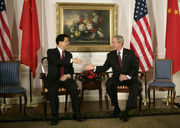
The PRC maintains diplomatic relations with most countries in the world. In 1971, the PRC replaced the Republic of China as the sole representative for "China" in the United Nations and as one of the five permanent members of the United Nations Security Council. It is considered a founding member of the UN, though the PRC was not in control of China at the time. (See China and the United Nations). The PRC was also a former member and leader of the Non-Aligned Movement.
Under the One-China policy, the PRC has made it a precondition to establishing diplomatic relations that the other country acknowledges its claim to Taiwan and sever any official ties with the Republic of China (ROC) government. The government actively opposes foreign travels by former and present Taiwanese officials, such as Lee Teng-hui and Chen Shui-bian, and other politically controversial figures, such as Tenzin Gyatso, the current Dalai Lama of Tibet, in an official context.
China has been playing an increasing role in calling for free trade areas and security pacts amongst its Asia-Pacific neighbors. In 2004, China proposed an entirely new East Asia Summit (EAS) framework as a forum for regional security issues that pointedly excluded the United States. The EAS, which includes ASEAN Plus Three, India, Australia and New Zealand, held its inaugural summit in 2005. China is also a founding member of the Shanghai Cooperation Organization (SCO), with Russia and the Central Asian republics.
Much of the current foreign policy is based on the concept of China's peaceful rise. However, conflicts with foreign countries have occurred at various times in its recent history, particularly with the United States; e.g., the U.S. bombing of the Chinese embassy in Belgrade during the Kosovo conflict in May 1999 and the U.S.-China spy plane incident in April 2001. Also, its foreign relations with many other Western nations suffered for a time following the Tiananmen Square Incident in 1989, sometimes referred to as the Tiananmen Square Massacre or June 4th Incident. The relationship between China and Japan has been strained at times by Japan's refusal to acknowledge its war-time past to the satisfaction of the PRC, e.g. revisionist comments made by prominent Japanese officials, and insufficient attention paid to the Nanjing Massacre and other atrocities committed during World War II in some Japanese history textbooks. Another point of conflict between the two countries is the frequent visits by Japanese government officials to the Yasukuni Shrine, which enshrines thousands of World War II war criminals, including 14 Class A convicts. Relations with China and Japan also have been strained by the Anti-Japanese Riots that occurred in spring of 2005. However, Sino-Japanese relations have warmed considerably since Shinzo Abe became the new Japanese Prime Minister in September 2006. A joint historical study to be completed by 2008 of WWII atrocities is currently being conducted by China and Japan.
Bordering the most countries in the world, the PRC is in a number of international territorial disputes. China's territorial disputes have led to several localized wars in the last 50 years, including the Sino-Indian War in 1962, the Sino-Soviet border conflict in 1969 and the Sino-Vietnam War in 1979. In 2001, the PRC and Russia signed the Treaty of Good-Neighborliness and Friendly Cooperation, which paved the way in 2004 for Russia to transfer Yinlong Island as well as one half of Heixiazi Island to China, ending a long-standing Sino-Russian border dispute. Other territorial disputes include islands in the East and South China Seas, and undefined or disputed borders with India, Tajikstan and North Korea.
Population policy
With a population of over 1.3 billion, the PRC is very concerned about its population growth and has attempted with mixed results to implement a strict family planning policy. The government's goal is one child per family, with exceptions for ethnic minorities and flexibility in rural areas, where a family can have a second child if the first is a girl or physically disabled. The government's goal is to stabilize population growth early in the 21st century, though some current projections estimate a population of anywhere ranging from 1.4 billion to 1.6 billion by 2025.
The policy is resisted, particularly in rural areas, because of the need for agricultural labour and a traditional preference for boys. Families who breach the policy often lie during the census. Official government policy opposes forced abortion or sterilization, but allegations of coercion continue as local officials, who are faced with penalties for failing to curb population growth, may resort to forced abortion or sterilization, or manipulation of census figures.
The decreasing reliability of PRC population statistics since family planning began in the late 1970s has made evaluating the effectiveness of the policy difficult. Estimates by Chinese demographers of the average number of children for a Chinese woman vary from 1.5 to 2.0. The government is particularly concerned with the large imbalance in the sex ratio at birth, apparently the result of a combination of traditional preference for boys, family planning pressure, and the wide availability of ultrasound, which led to its ban for the purpose of sex-selective abortion.
Human rights
The Constitution of the People's Republic of China guarantees freedom of speech, freedom of the press, the right to a fair trial, freedom of religion, universal suffrage, and property rights. However, censorship of political speech and information is openly and routinely used to protect what the government considers national security interests. The government has a policy of suppressing most protests and organizations that it considers a threat to social stability and national unity, as was the case with the Tiananmen Square protests of 1989. However, there are limits to the methods that the Party is willing or able to use as the media have become increasingly active in publicizing social problems, and exposing corruption and inefficiency at lower levels of government. The Party has also been rather unsuccessful at controlling information, and in some cases has had to change policies in response to public outrage. Although organized opposition against the Party is not accepted, demonstrations over local issues are frequently and increasingly tolerated.
At times, the PRC is faced with criticism from Western governments and NGOs concerning allegations of gross human rights violations. These criticisms allege that there existed a widespread practice of lengthy detentions without trial, forced confessions, torture, mistreatment of prisoners, as well as allegations of restrictions on freedoms of speech, assembly, association, religion, the press, and workers' rights. Furthermore, China leads the world in capital punishment, accounting for roughly 90% of total death-penalty executions in 2004, These issues remain one of the driving forces behind independence movements in Tibet and Xinjiang. The PRC government responds to these criticisms by arguing that the notion of human rights should factor in standards-of-living. It views the rise in China's standard-of-living as an indicator of improvement in the human rights issue.
In Reporters Without Borders' Annual World Press Freedom Index of 2005, the PRC ranked 159 out of 167 places. This is an indication that Reporters Without Borders considers the PRC one of the countries in the world with the strictest media control.
Political divisions
The People's Republic of China has administrative control over twenty-two provinces (省); the government of the PRC considers Táiwān (台湾) to be its twenty-third province. (See Political status of Taiwan for more information). Apart from provinces, there are five autonomous regions (自治区), each with a designated minority group; four municipalities (直辖市); and two Special Administrative Regions (特别行政区) that enjoy considerable autonomy.
The twenty-two provinces, five autonomous regions and four municipalities can be collectively referred to as " mainland China", a term which usually excludes Hong Kong, Macau.
The following are a list of administrative divisions of areas under the control of the People's Republic of China.
|
Provinces (省)
|
Autonomous regions (自治区)
|
|
Geography and climate
The PRC is the largest country in area in East Asia (excluding Russia) and the third largest in the world by land-and-sea area. (However, due to a recent change in the method used by the United States to calculate its surface area, some countries and international organisations list the United States as third largest.) It borders 14 nations (counted clockwise from south): Vietnam, Laos, Myanmar (Burma), India, Bhutan, Nepal, Pakistan, Afghanistan, Tajikistan, Kyrgyzstan, Kazakhstan, Russia, Mongolia and North Korea.
The territory of the PRC contains a large variety of landscapes. In the east, along the shores of the Yellow Sea and the East China Sea, there are extensive and densely populated alluvial plains, while on the edges of the Inner Mongolian plateau in the north, grasslands can be seen. Southern China is dominated by hill country and low mountain ranges. In the central-east are the deltas of China's two major rivers, the Huang He and Yangtze River (Chang Jiang). Other major rivers include the Xijiang River, Mekong, Brahmaputra and Amur.
To the west, major mountain ranges, notably the Himalayas with China's highest point Mount Everest, and high plateaus feature among the more arid landscapes such as the Taklamakan and the Gobi Desert.
A major issue is the continued expansion of deserts, particularly the Gobi Desert. Although barrier tree lines planted since the 1970s have reduced the frequency of sandstorms, prolonged drought and poor agricultural practices result in dust storms plaguing northern China each spring, which then spread to other parts of East Asia, including Taiwan, Korea and Japan. Dust from the northern plains has been tracked to the West Coast of the United States. Water, erosion, and pollution control have become important issues in China's relations with other countries.
China has some relevant environmental regulations: the 1979 Environmental Protection Law, which was largely modelled on U.S. legislation. But the environment continues to deteriorate. Twelve years after the law, only one Chinese city was making an effort to clean up its water discharges. This indicates that China is about 20 years behind the U.S. schedule of environmental regulation and 20 to 30 years behind Europe.
Water pollution has increased as an issue along with industrial production. The Chinese government has chosen a discharge standard measuring the concentration of a pollutant rather than the total pollutant load (as is done in the USA and many western countries). As a result many industrial dischargers in China simply dilute the effluent with river water taken from the same source as the receiving waters. Consequently the outcome has been to create considerable water pollution in many of the country's rivers.
With regard to carbon emissions, China was exempted from the Kyoto Protocol, and since that treaty was signed, China has become the world's number one emitter of carbon gases, adding to the threat of global warming.
Killing elephants for ivory has been a major cause of the decline of the African elephant population since at least the 1970s. Most of the ivory harvested is imported into the People's Republic of China and Thailand. For example, between 1996 and 2002 forty five tonnes of ivory in transit to China were seized by authorities. Quite recently China has agreed to reduce imports of ivory; however a Chinese official Chen Jianwei has indicated that many Chinese people are confused about the legality of ivory imports .
Military
The People's Liberation Army (PLA), with its 2.25 million active troops, is currently the largest military in the world. The PLA consists of an army, navy, air force, and strategic nuclear force. The official budget of the PLA for 2005 is $30 billion, possibly excluding foreign weapons purchases, military research and development, and the People's Armed Police, a paramilitary force.
The PRC, despite possession of nuclear weapons and delivery systems, is widely seen by military researchers both within and outside of China as having only limited power projection capability, so it is not yet considered to be a true superpower, though it is widely regarded as a major regional power. This is due to the limited effectiveness of its navy, which has no aircraft carriers (due to heavy US restriction).
Much progress has been made in the last decade and the PRC continues to make efforts to modernize its military. It has purchased state-of-the-art fighter jets from Russia, such as the Su-30s, and has also produced its own modern fighters, specifically the Chinese J-10s and the J-11s. It has also acquired and improved upon the Russian S-300 Surface-to-Air missile systems, which are considered to be among the best aircraft-intercepting systems in the world. The PRC's armoured and rapid-reaction forces have been updated with enhanced electronics and targeting capabilities. In recent years, much attention has been focused on building a navy with blue-water capability.
Economy
Beginning in late 1978, the Chinese leadership has been reforming the economy from a Soviet-style centrally planned economy to a more market-oriented economy that is still within a rigid political framework under Party control. The reforms replaced collectivization with privatization of farmlands, increased the responsibility of local authorities and industry managers, allowed a wide variety of small-scale enterprises to flourish, and promoted foreign investment. Price controls were also relaxed. These changes resulted in mainland China's shift from a planned economy to a mixed economy. China became a member of the World Trade Organization in 2001.
The government emphasizes personal income and consumption by introducing new management systems to help increase productivity. The government also focuses on foreign trade as a major vehicle for economic growth, which led to 5 Special Economic Zones (SEZ: Shenzhen, Zhuhai, Shantou, Xiamen, Hainan Province) where investment laws are relaxed so as to attract foreign capital. Since the 1990s, SEZs and similar concepts have been expanded to other major Chinese cities, including Shanghai and Beijing. The result has been a 6-fold increase of GDP since 1978. Chinese economic development is among the fastest in the world, and has been growing at an average annual GDP rate of 9.4% for the past 25 years. At the end of 2005, the PRC became the fourth largest economy in the world by exchange rate, and the second largest in the world after the United States by purchasing power parity at US$8,158 trillion. But with its large population this still gives an average GDP per person of only an estimated US$7,200, about 1/6th that of the United States. However, China is expected to surpass the US in all areas of economy at the earliest in 2020, at the latest in 2050.
Mainland China has a reputation as being a low-cost manufacturer, which caused notable disputes in global markets. This is largely because Chinese corporations can produce many products far more cheaply than other parts of Asia or Latin America, and because expensive products produced in developed countries like the United States are in large part uncompetitive compared to European or Asian goods. Another factor is the unfavorable exchange rate between the Chinese yuan and the United States dollar to which it was pegged.
On July 21, 2005 the People's Bank of China announced that it would move to a floating peg, allowing its currency to move against the United States dollar by 0.3% a day, while 3% a day against other currencies. Many high-tech American companies have difficulty exporting to China due to US federal government restrictions, which exacerbated the trade gap between the PRC and the US, and perceived low quality of US goods. On the other hand, China runs a trade deficit with Taiwan and South Korea, importing more from those nations than exports. China runs a large but diminishing trade surplus with Japan. (Slight deficit if Hong Kong is included). With the elimination of clothing quotas, China stands to take over a large chunk of the worldwide textile industry.
Preferential tax incentives are also given as a direct fiscal incentive to manufacture in China, whether for export or for the local market of 1.3 billion people. China is attempting to harmonize the system of taxes and duties it imposes on enterprises, domestic and foreign alike. As a result, preferential tax and duty policies that benefit exporters in special economic zones and coastal cities have been targeted for revision.
There is a large wealth disparity between the coastal regions and the remainder of the country. To counter this potentially destabilizing problem, the government has initiated the China Western Development strategy (2000), the Revitalize Northeast China initiative (2003), and the Rise of Central China policy (2004), which are all aimed at helping the interior of China to catch up.
There has been a significant rise in the Chinese standard of living in recent years. Today, a rapidly declining 10 percent of the Chinese population is below the poverty line. 98.9% of the youth population is literate, compared to 69.9% in the 1980s. The life expectancy in China is the third highest in East Asia, after Japan and South Korea. All of these statistics have been attributed partly to the Chinese economy, and toward the government, who has earned much praise in the 2000s.
Science and technology
After the Sino-Soviet split, China started to develop its own indigenous nuclear deterrent and delivery systems, successfully detonating its first surface nuclear test in 1964 at Lop Nor. A natural outgrowth of this was a satellite launching program, which culminated in 1970 with the launching of Dongfang Hong I, the first Chinese satellite. This made the PRC the fifth nation to independently launch a satellite. In 1992, the Shenzhou manned spaceflight program was authorized. After four tests, Shenzhou 5 was launched on October 15, 2003, using a Long March 2F rocket and carrying Chinese astronaut Yang Liwei, making the PRC the third country to put a human being into space through its own endeavors. With the successful completion of the second manned mission, Shenzhou 6 in October 2005, the country plans to build a Chinese Space Station in the near future and achieve a lunar landing in the next decade.
The Chinese government continues to place heavy emphasis on research and development by creating greater public awareness of innovation, and reforming financial and tax systems to promote growth in cutting-edge industries. President Hu Jintao in January 2006 called for China to make the transition from a manufacturing-based economy to an innovation-based one, and this year's National People's Congress has approved large increases in research funding. Controversial areas such as stem-cell research and gene therapy face minimal regulation in China.
China is also actively developing its software, semiconductor and energy industries, including renewable energies such as hydro, wind and solar power. In an effort to reduce pollution from coal-burning power plants, China has been pioneering the deployment of pebble bed nuclear reactors, which run cooler and safer, and have potential applications for the hydrogen economy.
The 863 Program is also part of China's science and technology focus. This program led to the development of the Godson computer processor.
Transportation
Transportation in the mainland of the People's Republic of China has improved remarkably since the late 1990s as part of a government effort to link the entire nation through a series of expressways known as the National Trunk Highway System (NTHS). Between 2001 and 2005, more than 25,000 km (16,000 mi) of expressways were built in China for a total of 41,000 km (25,000 mi), second only to the United States.
Private car ownership is increasing at an annual rate of 15%, though it is still uncommon due to government policies that make car ownership expensive, such as taxes and toll roads.
Air travel has increased, but remains too expensive for most. Long distance transportation is still dominated by railways and charter bus systems. The railways are still the vital carrier in China, and until this year steam locomotives were still a common sight. It is thought that some are still in use, especially on industrial networks.
Cities such as Beijing and Shanghai are building subways or light rail systems. Hong Kong has one of the most developed transport systems in the world. Shanghai already has a Maglev system connecting downtown Shanghai to Pudong International Airport
Demographics
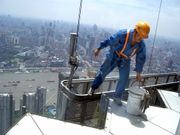
As of July 2006, there are 1,313,973,713 people in the PRC. About 20.8% (male 145,461,833; female 128,445,739) are 14 years old or younger, 71.4% (male 482,439,115; female 455,960,489) are between 15 and 64 years old, and 7.7% (male 48,562,635; female 53,103,902) are over 65 years old. The population growth rate for 2006 is 0.59%. The PRC officially recognizes 56 distinct ethnic groups, the largest of which are Han Chinese, who constitute about 91.9% of the total population. Large ethnic minorities include the Zhuang (16 million), Manchu (10 million), Hui (9 million), Miao (8 million), Uyghur (7 million), Yi (7 million), Tujia (5.75 million), Mongolians (5 million), Tibetans (5 million), Buyi (3 million), and Koreans (2 million).
In the past decade, China's cities expanded at an average rate of 10% annually. The country's urbanization rate increased from 17.4% to 41.8% between 1978 and 2005, a scale unprecedented in human history. Caught between urban and rural are the 80 to 120 million migrant workers who work part-time in the major cities of China and return home to the countryside periodically with their earnings.
Today, the People's Republic of China has dozens of major cities with one million or more long-term residents, including the three global cities of Beijing, Hong Kong, and Shanghai. Major cities in China play key roles in national and regional identity, culture and economics.
Largest Cities
The figures below are the 2001 estimates for the ten largest urban populations within administrative city limits; a different ranking exists when considering the total municipal populations (which includes suburban and rural populations). The large floating populations of migrant workers make conducting censuses in urban areas difficult; the figures below do not include the floating population, only long-term residents.
| Rank | City urban area | Type/location | Population (2001 est) millions |
Density (2001 est) per km² |
Municipality limits (2000 census) |
Region | |
|---|---|---|---|---|---|---|---|
| millions | density (/km²) | ||||||
| 1 | Shanghai | municipality | 9.838 | 34,700 | 16.74 | 2,640 | East |
| 2 | Beijing | municipality | 7.441 | 29,800 | 13.82 | 822 | North |
| 3 | Hong Kong | SAR | 6.112 | 76,200 | 7.01 | 6,294 | South Central |
| 4 | Tianjin | municipality | 5.095 | 10,500 | 10.01 | 803 | North |
| 5 | Wuhan | Hubei province | 4.489 | 12,950 | 8.31 | 947 | South Central |
| 6 | Guangzhou | Guangdong province | 4.155 | 11,600 | 10.15 | 1,337 | South Central |
| 7 | Shenyang | Liaoning province | 3.981 | 9,250 | 7.20 | 557 | Northeast |
| 8 | Chongqing | municipality | 3.934 | 23,500 | 30.90 | 378 | Southwest |
| 9 | Nanjing | Jiangsu province | 2.822 | 13,250 | 6.40 | 970 | East |
| 10 | Harbin | Heilongjiang province | 2.672 | 11,350 | 9.35 | 174 | Northeast |
Education
In 1986, China set the long-term goal of providing compulsory nine-year basic education to every child. As of 1997, there were 628,840 primary schools, 78,642 secondary schools and 1,020 higher education institutions in the PRC. In February 2006, the government advanced its basic education goal by pledging to provide completely free nine-year education, including textbooks and fees, in the poorer western provinces. As of 2002, 90.9% (male: 95.1%; female: 86.5%) of the population over age 15 are literate.
The quality of Chinese colleges and universities varies considerably across the country. The consistently top-ranked universities in mainland China include Tsinghua and Peking in Beijing, Fudan and Shanghai Jiaotong University in Shanghai, Nanjing University in Nanjing, the University of Science and Technology of China in Hefei, Wuhan University in Wuhan,and Zhejiang University in Hangzhou.
Many parents are highly committed to their children's education, often investing large portions of the family's income on education. Private lessons and recreational activities, such as in foreign languages or music, are popular among the middle-class families who can afford them.
Public health
The Ministry of Health, together with its counterparts in the provincial health bureaus, oversees the health needs of the Chinese population. An emphasis on public health and preventative treatment characterized health policy since the early 1950s. At that time, the party started the Patriotic Health Campaign, which was aimed at improving sanitation and hygiene, as well as attacking several diseases. This has shown major results as diseases like cholera, typhoid, and scarlet fever were nearly eradicated.
With economic reform after 1978, the health of the Chinese public improved rapidly due to better nutrition despite the disappearance, along with the People's Communes, of much of the free public health services provided in the countryside. Health care in China became largely private fee-for-service. By 2000, when the World Health Organization made a large study of public health systems throughout the world, The World Health Report 2000 Health Systems: Improving Performance the Chinese public health system ranked 144 of the 191 UN member states ranked.
The country's life expectancy jumped from about 32 years in 1950 to almost 73 years in 2006, and infant mortality went down from 300 per thousand in the 1950s to about 23 per thousand in 2006. Malnutrition as of 2002 stood at 12 percent of the population according to United Nations FAO sources .
Despite significant improvements in health and the introduction of western style medical facilities, the PRC currently has several emerging public health problems, which include respiratory problems as a result of pollution and millions of cigarette smokers, a possible future HIV-AIDS epidemic, and an increase in obesity among urban youths. China's large population and close living quarters has led to some serious disease outbreaks in recent years, such as the 2002 outbreak of SARS (a pneumonia-like disease) which has since been contained.
Culture
For centuries, opportunity for economic and social advancement in China could be provided by high performance on imperial examinations. The literary emphasis of the exams affected the general perception of cultural refinement in China, such as the view that calligraphy was a higher form of art than painting or drama. China's traditional values were derived from various versions of Confucianism and conservatism. A number of more authoritarian strains of thought have also been influential, such as Legalism. There was often conflict between the philosophies, such as the individualistic Song Dynasty neo-Confucians, who believed Legalism departed from the original spirit of Confucianism. Examinations and a culture of merit remain greatly valued in China today. In recent years, a number of New Confucians have advocated that democratic ideals and human rights are quite compatible with traditional Confucian "Asian values".
The first leaders of the People's Republic of China were born in the old society but were influenced by the May Fourth Movement and reformist ideals. They sought to change some traditional aspects of Chinese culture, such as rural land tenure, sexism, and a Confucian education, while preserving others, such as the family structure and obedience to the state. Many observers believe that the period following 1949 is a continuation of traditional Chinese dynastic history, while others say that the CPC's rule has damaged the foundations of Chinese culture, especially through political movements such as the Cultural Revolution, where many aspects of traditional culture were labeled 'regressive and harmful' or 'vestiges of feudalism' by the regime. They further argue that many important aspects of traditional Chinese morals and culture, such as Confucianism, Chinese art, literature, and performing arts like Beijing opera, were altered to conform to government policies and communist propaganda. The institution of the Simplified Chinese orthography reform is controversial as well.
Today, the PRC government has accepted much of traditional Chinese culture as an integral part of Chinese society, lauding it as an important achievement of the Chinese civilization and emphasizing it as vital to a Chinese national identity. Modern Chinese art, literature, music, film, fashion and architecture have become increasingly ready to incorporate various degrees of traditional Chinese culture into their works.
Religion
The majority of Chinese identify themselves as non-religious, which constitute about 59% of the population, or about 767 million people. However, religion and rituals play a significant part in the lives of many, especially the traditional beliefs of Confucianism and Taoism. About 33% of the population follow a mixture of beliefs usually referred to by statisticians as "Traditional Beliefs" or just "Other".
About 6% of the Chinese population are avowed Buddhists, with Mahayana Buddhism (大乘) and its subsets Pure Land (净土宗) and Zen (禅宗) being the most widely practiced. With an estimated 100 million adherents, Buddhism is the country's largest organized religion. Other forms of Buddhism, such as Theravada Buddhism and Tibetan Buddhism, are practiced largely by ethnic minorities along the geographic fringes of the Chinese mainland. Official figures indicate that there are currently about 20 million Muslims (mostly Hui), more than 15 million Protestants, and 5 million Catholics in the country.
Falun Gong, developed in the 1990s, has attracted great controversy after the Chinese government labeled it a malicious cult and attempted to eradicate it. The Falun Gong itself denies that it is a cult or a religion, but rather a "spiritual practice." Falun Gong claims approximately 70-100 million followers, a number which is rejected by foreign independent groups and the Chinese government, though exact numbers are unknown.
Sports and recreation
China has one of the oldest sporting cultures in the world, spanning the course of several millennia. There is, in fact, evidence that a form of football was first played in China around 1000 AD, leading many historians to believe that the popular sport originated from China. Besides soccer, some of the most popular sports in the country include martial arts, table tennis, badminton, basketball, rugby, and more recently, golf. Board games such as Chess, Go (Weiqi), and Xiangqi (Chinese chess) are also commonly played and have organised competitions.
Physical fitness is widely emphasized in Chinese culture. Morning exercises are a common activity and oftentimes one can find the elderly practicing qigong in parks or students doing stretches on school campuses. Young people are especially keen on basketball, especially in urban centres with limited space and grass areas. The NBA has a huge following among Chinese youths, with Yao Ming being the idol of many. The 2008 Summer Olympics, officially known as the Games of the XXIX Olympiad, will be held in Beijing, China.
Many traditional sports are also played. The popular Chinese dragon boat racing occurs during the Duan Wu festival. In Inner Mongolia, sports such as Mongolian-style wrestling and horse racing are popular. In Tibet, archery and equestrian sports are a part of traditional festivals.
Foreign Stereotyping
The following Chinese stereotypes of foreigners are taken from Culture Shock! China by Kevin Sinclair and Iris Wong Po-Yee.
- Non-Chinese: Pitful barbarians who, if they become troublesome in China, can be speedily kicked out of the country.
- Americans: All crazy, but also generous, friendly people led by treacherous warmongering politicians. If they are female, probably have sexual designs on innocent Chinese boys. If male, likewise, except on Chinese girls as well as boys.
- Germans: Clever, technically brilliant people, hardworking but overweight and often drunk.
- French: Flamboyant and foppish, not serious but very artistic. Verging on constant anarchy.
- British: Devious, tough, ruthless, and brutal. Not to be trusted in any deal unless there is an obvious reason for them to keep their word. Stylish and stole the idea of tea drinking.
- Australians: Acceptable as business partners, generally a rowdy, hard-drinking people. A likeable bunch of lunatics who speak an incomprehensible dialect of English.
- New Zealanders: Poor cousins to Australians except they get drunk faster. Always complaining and saying how everything is better back home.
- Canadians: Nice, honest, open, and generous farmers who can be trusted. Easy to do business with because they are a bit simple.
- Russians: Brutal thugs itching to steal more northern territory from China. Not to be trusted. But they serve as an important lesson to the Chinese of what happens when a superpower collapses; therefore most useful to the leadership.
- Africans: Sex-crazed, drug-addicted womanisers who are talented dancers.
- Filipinos: Poor yankees who yodel and pluck guitars. Not serious people. But they are no threat to China, so are tolerated.
- Italians: Cultural robbers who stole the idea of noodle from China and called it spaghetti. Smooth and handsome romancers who drive fast cars. Watch out for them.
- Latin Americans: Victims of grasping American bankers (which makes them good guys) and conspirators who flood the world with drugs (which makes them bad guys).
- Arabs: Constant tormentors of western countries who keep western barbarians occupied outside of China. Therefore good. Often encourage Islamic extremism in Xinjiang and Ningxia. Therefore most dangerous and untrustworthy.
- Japanese: Arrogant bandits awaiting opportunities to rob China's riches and control the country, as they have done before in WWII.


